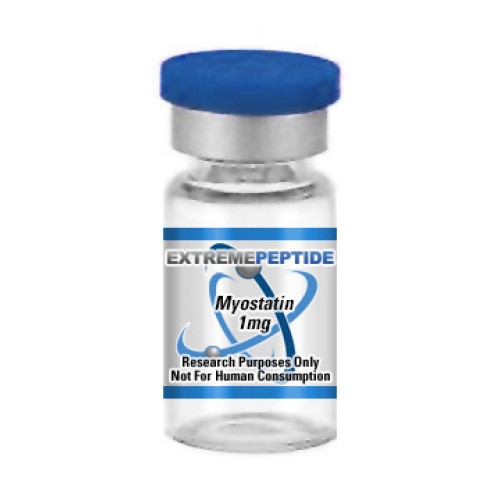Download or view the PDF version of this article by clicking here
Myostatin HMP is a protein that is considered an inhibitor of growth differentiation factor. It can be referred to by several different names, including Growth Factor 8, Differentiation Factor 8, GDF-8, GDF8, Myostatin, and MSTN. When it is used in conjunction with scientific study based on animal test subjects, it has the appearance of a white powder. The peptide has a molecular weight of 25.0 kDa.
Myostatin HMP vs. Myostatin
According to scientific study that has been conducted on animal test subjects, the primary purpose of Myostatin HMP is to act as an inhibitor to myostatin.
Myostatin has been determined to be a secreted growth differentiation factor, meaning that it is part of a subfamily of proteins that are part of the transforming growth factor beta superfamily that have functions chiefly associated with development. Specifically, it is part of the TGF beta protein family that blocks the process of muscle differentiation and growth in myogenesis, which is the process in which muscular tissue is formed particularly during embryonic development. The peptide is chiefly produced via skeletal muscle cells. It also circulates throughout the blood and is known to act on muscle tissue by binding a cell-bound receptor that is known as the activin type II receptor.
When the peptide binds to the receptor, it results in the recruitment of a coreceptor known as either Alk-3 or Alk-4. This particular coreceptor in turn commences with a cell signaling cascade within the muscle, which includes the activation of transcription factors with the SMAD family, which are intracellular proteins that transducer extracellular signals from transforming growth factor beta ligands to the nucleus where they turn on downstream gene transcription. Specifically, the peptides are known to activate SMAD2 and SMAD3. These particular factors in turn initiate gene regulation that is specific to myostatin. When applied to myoblasts – that is, the impetus that creates the long, tubular cells that gradually develop into muscle fibers – the peptide inhibits their differentiation into mature fibers.
Additionally, scientific study that has been conducted on animal test subjects has determined that Myostatin also blocks Akt, a kinase that has been thought to be sufficient enough to cause muscle hypertrophy (that is, an increase in the size of skeletal muscle) partially via the activation of protein synthesis. As such, the peptide is thought to act by inhibiting muscle differentiation and by inhibiting Akt-induced protein synthesis. Furthermore, the peptide has been classified as a myokine. In other words, it is considered to be a peptide that is produced, expressed, and released by muscle fibers and are known to exert endocrine, paracrine, or autocrine effects.
Myostatin HMP’s Effects
Scientific study based on animal test subjects has determined that Myostatin HMP’s ability to inhibit the production of Myostatin lessens the regulatory effects on skeletal muscle growth. Because Myostatin is blocked, the muscles within an animal test subject are allowed to grow freely without being regulated to stop at a certain point within a certain time frame or interval. This process is further heightened when it is considered that the presence of Myostatin inhibits the production of Akt, and therefore its ability to promote muscle hypertrophy.
Myostatin HMP and Muscle Growth
Because of the ability that Myostatin HMP has in terms of inhibiting the production of myostatin, scientific study that has been based on animal test subjects has determined that the peptide could play a key factor into accelerating muscle growth. Because the regulatory processes that exist behind the presence of Myostatin, it is therorized that the presence of Myostatin HMP and its ability to inhibit myostatin can cause an increase in muscle growth and muscle size to happen on a more efficient basis. Some studies have also theorized that the increase in muscle growth efficiency could have secondary benefits. For example, it is thought that the acceleration of muscle tissue growth could conceivably cause acceleration in the breakdown of adipose tissue (that is, body fat). The theory here is that the energy that is needed for muscle growth is turned into the muscular building blocks would be expended at a much faster rate. As such, it leaves little time for adipose tissue to develop. It would also cause any excess adipose tissue that had been built up over time to break down for purposes of energy conversion on a significantly faster rate, thus making it easier to break down any excess weight.
Click here to read Myostatin HMP – Part 2
